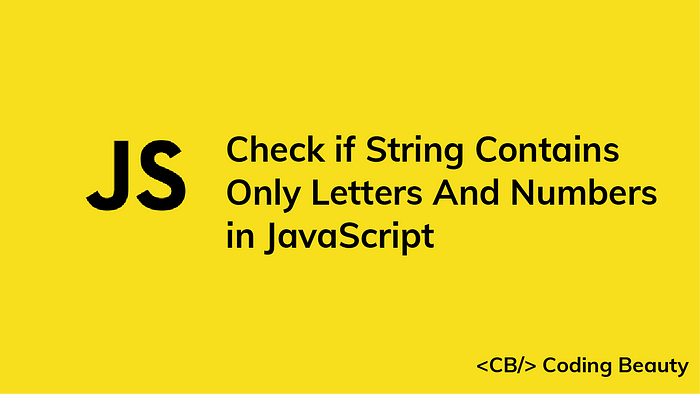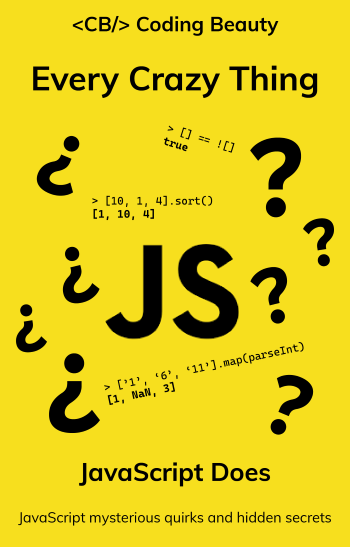
1. The RegExp test() Method
To check if a string contains only letters and numbers in JavaScript, call the test() method on this regex: /^[A-Za-z0-9]*$/. If the string contains only letters and numbers, this method returns true. Otherwise, it returns false.
function onlyLettersAndNumbers(str) {
return /^[A-Za-z0-9]*$/.test(str);
}
const str1 = 'number60';
const str2 = 'contains spaces';
const str3 = 'has special characters !@#$%^&';
console.log(onlyLettersAndNumbers(str1)); // true
console.log(onlyLettersAndNumbers(str2)); // false
console.log(onlyLettersAndNumbers(str3)); // false
The RegExp test() method searches for a match between the regular expression and a specified string.
The / and / characters are used to start and end the regular expression.
The ^ character matches the beginning of the string, while the $ character matches the end of the string.
The square brackets ([]) are used to match any one of multiple specified patterns. In our example, we specify three patterns: A-Z, a-z, and 0-9.
A-Z matches any uppercase letter.
a-z matches any lowercase letter.
0-9 matches any digit.
The * character matches zero or more occurrences of a particular pattern. We add it after the square brackets to match any of the patterns in the brackets as many times as possible.
2. The String match() Method
We can use the String match() method in place of RegExp test().
function onlyLettersAndNumbers(str) {
return Boolean(str.match(/^[A-Za-z0-9]*$/));
}
const str1 = 'number60';
const str2 = 'contains spaces';
const str3 = 'has special characters !@#$%^&';
console.log(onlyLettersAndNumbers(str1)); // true
console.log(onlyLettersAndNumbers(str2)); // false
console.log(onlyLettersAndNumbers(str3)); // false
The String match() method returns an array of all the matches of a regular expression in a string. If there are no matches, it returns null.
const str1 = 'number60';
const str2 = 'contains spaces';
const str3 = 'has special characters !@#$%^&';
// [ 'number60', index: 0, input: 'number60', groups: undefined ]
console.log(str1.match(/^[A-Za-z0-9]*$/));
console.log(str2.match(/^[A-Za-z0-9]*$/)); // null
console.log(str3.match(/^[A-Za-z0-9]*$/)); // null
We pass the result of match() to the Boolean constructor to convert it to a Boolean. Boolean() converts truthy values to true, and falsy values to false.
In JavaScript, there are six falsy values: undefined, null, NaN, 0, '' (empty string), and false. Every other value is truthy.
console.log(Boolean(undefined)); // false
console.log(Boolean(['number60'])); // true
console.log(Boolean(null)); // false
console.log(Boolean(5)); // true
Removing Letters and Numbers from a String
If you would like to remove any letters and numbers from the string, you can use the String replace() method.
function removeLettersAndNumbers(str) {
return str.replace(/[A-Za-z0-9]/g, '');
}
const str1 = 'number!60 ?';
const str2 = '#wel_com%e';
console.log(removeLettersAndNumbers(str1)); // ! ?
console.log(removeLettersAndNumbers(str2)); // #_%
The String replace() method returns a new string with some or all matches of a specified pattern replaced by a replacement. We use an empty string ('') as the replacement to have all the letters and numbers removed in the resulting string.
We use the g (global) flag to match all the occurrences of the pattern in the string. If we don't specify this flag, only the first match of a letter or number will be removed.
function removeLettersAndNumbers(str) {
// 'g' flag not set
return str.replace(/[A-Za-z0-9]/, '');
}
const str1 = 'number!60 ?';
const str2 = '#wel_com%e';
console.log(removeLettersAndNumbers(str1)); // umber!60 ?
console.log(removeLettersAndNumbers(str2)); // #el_com%e
Updated at: codingbeautydev.com
Every Crazy Thing JavaScript Does
A captivating guide to the subtle caveats and lesser-known parts of JavaScript.

Sign up and receive a free copy immediately.